人の楽しみの発見度:Very Good ★★☆(渡辺尚志、2009)
This book depicts the ordinary people in the Edo period, they were farmers. The author is a professor who researches about farmers in the Edo period. The book might have been a little difficult for
foreign readers, who are not familiar with Japan in the Edo period. So I didn’t cover some items in
English article.
Contents
1. Family
(Ie) and village in the Edo period
2. Life
of farmers
3. Farming
4. Bringing-up,
education and enjoyment of culture
5.
Farmers as battlers
このブログのテーマである、江戸時代に生きた普通の人々、その多数を占めた百姓の暮らしについての本である。一橋大学の教授が書いた本で、バックグラウンドを知らない外国人には理解しにくい要素が多いと思う。著者は、江戸時代の人口の八割以上を占めた百姓に寄り添った研究を続けており、緻密に調べあげられている。
目 次
第一章 江戸時代の家と村
第二章 百姓たちの暮らし
第三章 働く百姓たち
第四章 百姓の育ち・学び・遊び
第五章 たたかう百姓たち
1. Family (Ie) and village in the Edo period 江戸時代の家と村
- The population
in the Edo period (from 1603 to 1868)
In the early Edo period, the population was 12
to 15 million. It increased to 31 million in 1721 because of the development of the farming productivity and expanding of the farming fields during the 17th century. However, it was still 33 million in 1873 because of limited farming field, famine
and plague.
The number of the children per family at the late Edo period was two or three. Men were married at 25-28 years old, and
women were married at 18-24. When I got married in the late part of 20th
century, average marring age for men was 28 and 24 for women, so almost same as the Edo period. However in 2016, the average changed to 31 and 29 . Average life
expectancy was about 30 in the early Edo period, but it increased to late 30 in the end of the Edo period. Adults could live over 50, so the baby
mortality rate was high.
 |
| Farmer’s children @ Nagareyama city museum、流山市博物館 |
- Family (Ie)
The meaning of the “Ie” is more than just “family”
or “house” and of course the family name. The word can also be
used when talking about one’s ancestors or descendants. The mission of
farmers was to continue the “Ie”, and it was a reason to live for them.
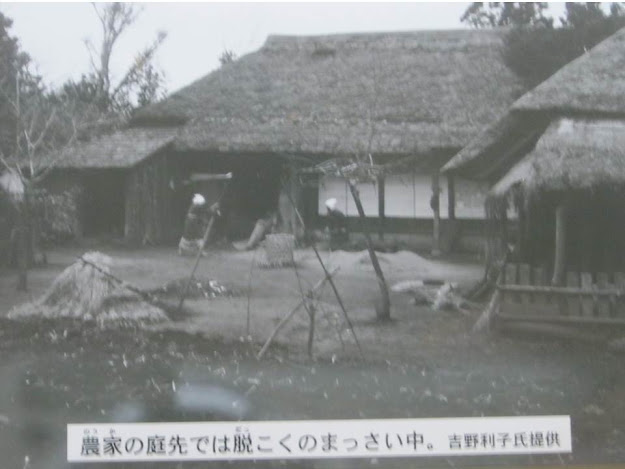 |
| Farmer’s house @ Nagareyama city museum、流山市博物館 |
- Village
Village was the basic unit for farming
and administration. The bond of the villagers was so strong because mutual cooperation
was necessary for them to farm and to live. The average population of one village was about 400.
・江戸時代の人口
江戸時代の人口は、17世紀の新田開発と農業生産力の向上で急増した。1600年の推定人口は1200~1500万人だったが、120年後の1721年には3128万人になった。だが、更に150年後の明治6年(1873年)は3330万人に留まった。耕地面積の頭打ちと飢饉や疫病を背景とした少子化と晩婚化によるという。
江戸後期の一家の子供の数は2、3人で、少なく生んで手間暇かけて育てるようになった。また、18、19世紀の平均初婚年齢は、男25~28歳、女18~24歳で、17世紀に比べ、男で2歳、女で3歳ほど初婚年齢が上がっているという。私が結婚した1990年頃は男28歳、女24歳だったからあまり変わらない。ちなみに、2016年は、男31歳と女29歳であり晩婚化が進んでいる。一方、平均寿命は江戸初期で30歳ぐらい、江戸末期で30歳後半であり、乳幼児死亡率の高さの影響が大きい。成人すれば、50歳以上生きる。
・生産単位としての家の成立
江戸時代の家は、家名・家業・家産(財産)の一体性を持ち、先祖や子孫も含まれた生産・生活の単位だったとある。家の当主は、代々同じ名を名乗って家名とした。先祖から預かった家を守り伝えるのが百姓の生き甲斐であった。となると、日々平穏に暮らせただけで満足であり、楽しみになると私は思う。15世紀頃までは、家業が不安定で家産を維持することは難しく、「家も広範には成立しえなかった」と書かれている。
・村
村は、江戸時代の基礎的な集団で、村民が協力して生産を営むとともに領主が支配する単位になっていた。江戸時代の村の数は、1697年で63,276、1834年で63,562であった。平均の面積は約500,000㎡、人口は約400人で今の村より随分小さい。大字が村を継いでいる場合があるという。
2. Life of farmers 百姓たちの暮らし
(1) Livelihood
The Sakamoto family in the upper class was
depicted as the typical farmer. The number of the family was five to eight. They
produced rice, wheat, soy beans and so on. They hired one or two helpers, and
they hired 15 to 30 helpers in the busy season such as rice planting and
harvesting. They lived in Nagano which is a mountainous area.
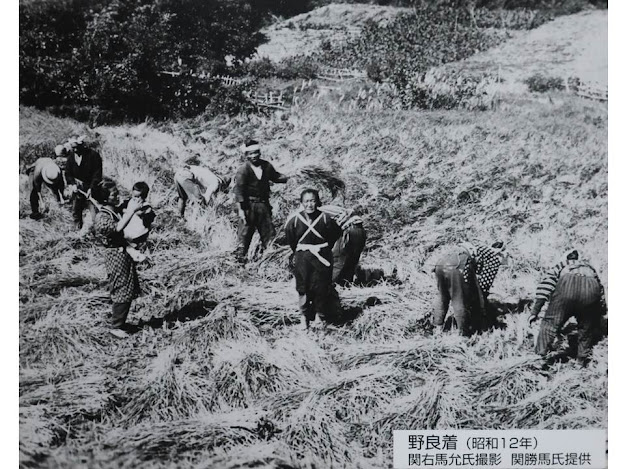 |
| Rice harvesting in 1927 @ Hitachi City Museum、日立市郷土博物館 |
(1) 百姓の生業
この章では代表的な村人として長野県諏訪の名主も務める坂本家を取り上げている。家族は2~3世代で5~8人とのこと。米の他に、大麦、小麦、粟、稗、蕎麦、大豆、小豆、大根、菜、油荏(あぶらえ)、たばこなどを栽培していた。
貨幣経済が浸透しており、米や蕎麦などの穀物を販売した収入がある。貨幣が必要なものとして、種子、農機具、馬関係の費用があり、記録から読み取れる。坂本家は、甲州街道沿いにあったため、米、大豆の他、畳、味噌などを販売していた。また、旅人相手の宿屋も営んでいた。農業や家の手伝いとして1~2人の年季奉公人を雇っている他、田植稲刈りの繁忙期に15~30人を雇っている。
(2) Daily life
-Clothing
The material of clothes was changed to cotton
from hemp in the late Edo period because cotton was comfortable and warm.
 |
| Work clothes @ Ryuugasaki city museum of history and folklore 龍ヶ崎市歴史民俗資料館 |
(2) 百姓の日々の暮らし
・衣:着ていたのは、木綿、麻の他、禁じられていた絹織物もあった。化粧道具も購入している。木綿は中世に日本に伝わったが、従前の麻と比べて保温性と着心地が良いので、江戸時代になると庶民の衣料素材として広がった。もう一つの変化が、ファッション化。多少高くても、見栄えの良い衣服を選ぶようになってきたそうだ。
-Food
They bought
various kinds of fishes, dried fishes, chickens, eggs, vegetables, fruits (persimmon, chestnuts, oranges, plums and so on), seaweeds, tofu, fried tofu, noodles,
sweets, senbei cookies, tea leaves, sake alcohol, tobacco, salt, sugar and so
on. However, they didn’t eat pork and beef.
They ate noodles, buns or porridge in the
morning and evening. They ate steamed rice and wheat for lunch.
At the party, they had rich course menu. The
menu of the wedding reception in 1853 remained.
Appetizers equivalent:
Kazunoko
fish eggs, squid, vegetable, soup and so on
Mae-zen: The first meal
Sashimi
raw fish, baked egg, mushroom and so on. Plus sake alcohol.
Hon-zen: Main meal
Sashimi
raw fish, chicken, vegetable, mushroom, soup and rice.
Nino-zen: The second meal
Fish,
shrimp, vegetable, soup and so on. Plus sake alcohol.
The last meal
Fish,
egg, vegetable, soup, sweets (Youkan) and so on.
I was surprised that they ate
such various foods on the special day. Nagano is far from the sea, but they ate
raw fishes. Was it freshwater fish like a trout?
 |
| Zen tray @ Hirakata-shuku Kagiya Museum 枚方宿鍵屋資料館 |
Reference: Dishes for the wedding ceremony which I attended in 2018 (Japanese style)
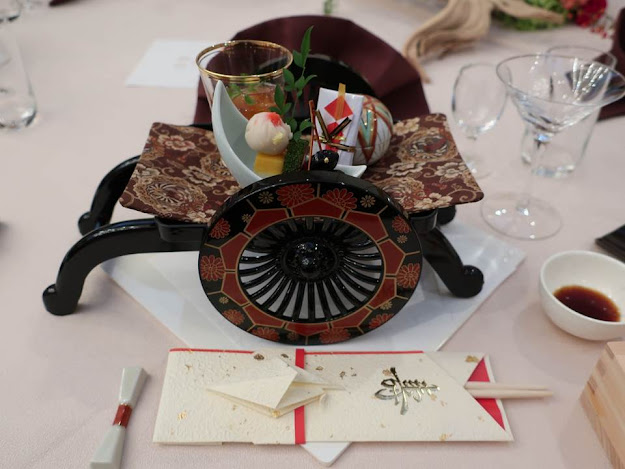 |
| Starter、肴 |
 |
| Clear soup、吸い物 |
-淡水産の魚介類:ヤマメをよく買っており、鮒(串焼きもあり)、海老、しじみ、はや、鰻
-海水産の魚介類:干物、鰹節などの節、田作、するめ、鰯、鯖、鮪が多く、いなだ、さんま、しらす、さけ、きす、にしん、あじ、鳥貝も買っている。
-鳥獣類:鶏、卵(いずれの自給のため売ることもあり)、きじ、鳩をたまにかっている。
-野菜類:人参、芋、生姜、牛蒡が多く、瓜、胡麻、松茸、茄子、里芋、山芋、からし、干し大根、うどなども買っている。
-果物:柿を毎年のように買っており、栗、みかん、梨、梅、柚子、胡桃を買っている。
-植物性海産物:昆布、ひじき、あらめ(荒布)、青海苔、浅草海苔
-加工食品:豆腐を頻繁に買い、蒟蒻、麩、凍豆腐、干瓢、油揚げ、おから、ところてん、そうめんも買う。納豆は自家製造。
-菓子:煎餅、飴、落雁、氷砂糖を頻繁に購入
-嗜好品:茶、酒、焼酎、煙草(自給)。甘酒は自家製造。
-調味料:塩、酢、たまり、白砂糖、黒砂糖、味醂、味噌(自家製造もあり)
*有薗正一郎氏は、米の生産量と人口から、百姓が食べられる米は十分にあった(年間穀物消費量1.5石≒225kgの半分以上が米食だった)と推計している。ただ、地域差、貧富の差で食べる機会が少なかった人もいるが、百姓が米を食べられなかったというのは間違いだと筆者は指摘している。
・信濃の国の食事(江戸時代後半)
坂本家のあった信濃では、朝と晩は粉もの(うどん、そば、おやき類)や粥を食べ、昼は麦飯(米と麦に大根の葉などを混ぜて炊いた飯)を食べた。
坂本家に近い富士見町の上層百姓の結婚式(1853年)のご馳走として下記が紹介されている。
‐お茶
‐吸い物(花鰹、そうめん、せり)、数の子、ふき、田作、イカ、昆布と冷酒
‐前膳:吸い物、ネギの酢味噌和え、玉子焼き、イナゴ、刺身、皿(錦糸玉子、タコ、せり、椎茸など)
‐本膳:皿(千切り大根、刺身、岩茸、鳥、なます)、肴(栗、するめ、人参など)、汁(田作、大根)、小鉢(蒟蒻など)、飯
‐二の膳:皿(椎茸、牛蒡、鱒、するめ、昆布、ちくわ)、組合せ(海老、切り身、イナゴ)、汁(きじ)、奈良漬と清酒
‐タコ、ぜんまい、海老、刺身、蓮根、九年母の果実、玉子、羊羹、はも、しらすなどと吸い物
婚礼の時間も一昼夜と長いのだろうが、豊富な食事で驚いた。刺身は鱒のような川魚だろうか。
-Housing
Typical
layout is shown below. When you entered the farmer’s house, the first room had
an earth floor, cooking stoves and a sink. The kitchen had a wooden floor and
irori fire place. They had meals around the fire place and chatted.
 |
| Earth floor土間 @ Sakano’s house 坂野家住宅 |
 |
| Irori fireplace囲炉裏@ Sakano’s house 坂野家住宅 |
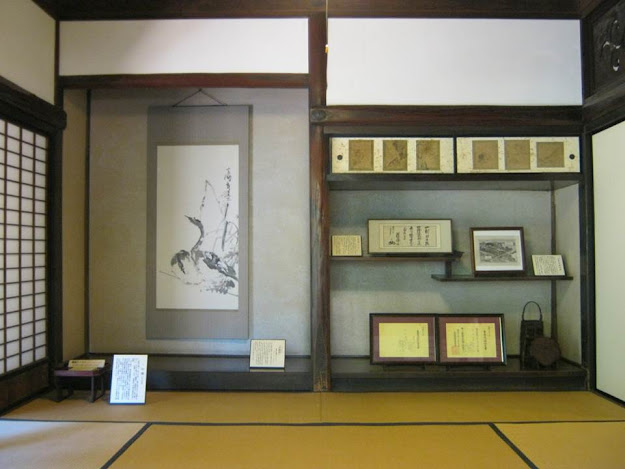 |
| Zashiki guest room 座敷@ Sakano’s house 坂野家住宅 |
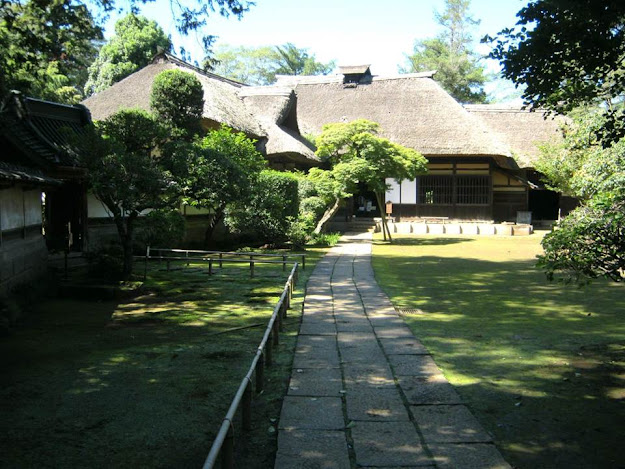 |
| Sakano’s house 坂野家住宅 |
家の普請のために毎年大工を入れているが、近隣に手伝いを頼んでいる。
-Medical care
They depended on the herbal
medicine and prayer. There was a doctor near their village.
・医療:祈祷を受けたり、薬草などからとった薬を買ったりとなる。薬は、近在の医者からもらう場合、近隣の商人から買う場合、行商から買う場合があるが、近江国日野や信濃国伊那の商人から購入した記録が残っている。使った分だけ補充する富山の薬売り方式だ。
 |
-Nursing
All family members were
engaged in taking care of elderly members, not only the wife. The villagers played
important roles to take care of single elderly villagers. Neighbors visited them frequently,
and they made meals and washed clothes for them. The wealthy villagers donated foods
and lent money to them. Some elderly people or sick people adopted children who took care of them. On the other hand, the support of the government was not enough.
・介護:第一の特徴は、介護は家の責任で、妻ではなく家長の統率の元に家族が協力して行った。第二の特徴は村の役割が大きく、単身の高齢者を近所の人が頻繁に見舞ったり、食事や洗濯の世話をした。富裕な農民や村役人は、食料を与えたり、お金を貸したりした。一般の村人も少ないながら経済的な援助をした。家族を亡くした高齢者や病人は養子を迎えることもあった。幕府や藩の支援は不十分であった。柳谷慶子氏の研究を引いている。
-Faith
This book was interesting
because the religious activities were investigated through expenditure records. They
visited shrines and temples, for example, they visited Suwa Shrine almost every year which
was not so far. They also visited Ise Shrine in 1795, Fuji in 1800, Minobu Temple
in 1814 and Zenkouji Temple in 1832. Ise is more than 200km away from their
village.
The Oshi, who is a
priest and a travel agent of the shrine, visited the village every year. The
Oshi from Taga Shrine in Shiga stayed at his house and visited the villagers
in order to invite them to the Taga Shrine. The Oshis from Ise and Tsushima
also visited the village.
 |
| Suwa Shrine Kami Sya、諏訪大社上社 |
Talking about temples and shrines which were located in their village, they donated to their family temple regularly.
They spent money when the festivals and himachi events were held. They gave pocket
money to the children during the festivals. Festivals would have been big fun
for children.
・信仰:支出から見ているので面白い。まず、御師。多賀(滋賀県)、津島(愛知県)、伊勢の御師がほぼ毎年来村しているという。多賀御師は坂本家に宿泊して近隣を回っている。次に寺社参詣。諏訪大社にはほぼ毎年出かけ、伊勢(1795年)、富士(1800年)、身延山(1814年)、善光寺(1832年)への参詣の記録がある。比較的近地が多く10年に一度程度の旅になっている。三番目は村内・近在の寺社への支出であるが、檀那寺には年始のほか折にふれて出金している。神社では、鎮守の祭礼、道祖神の小正月の祭りの時の子供たちへの小遣い、田の神様、日待ちにも出金している。最後に、家内での線香、過去帳、盆提灯などの出費が記載されている。
 |
| Village shrine in Chiba |
-Entertainment
They went to the summer
festival, so the master gave pocket money to the children and helpers. When the
Kabuki play was held in the festival, masters paid money to support it and villagers
played the Kabuki. Different kinds of performances including a puppet show were
held too. Sumo wrestling were also held while the festival. Younger villagers
organized these events and rich villagers donated to them.
・娯楽(祭り、歌舞伎、相撲):祭りのときには歌舞伎や相撲が行われたとのこと。これも、支出から調べている。
 |
| Sumo in the village @ Kashiwa city artifacts room、柏市郷土資料展示室 |
 |
Performance in the village、村芝居
|
・娯楽(祭り、歌舞伎、相撲):祭りのときには歌舞伎や相撲が行われたとのこと。これも、支出から調べている。
‐祭り:近隣の御射山(みさやま)社の祭礼が7月27日行われ、子供や奉公人は小遣をもらって出かけている。
‐歌舞伎:村人が演じて奉納したもので、入用割合(公演費用の分担)、祝儀、小遣を支出している。芝居、見せ物、浄瑠璃への支出もある。
‐相撲:近隣の村での興行も含めて、入用割合、小遣を出金している。
また、これらを主催していた若者組(村の青年男子の組織)にも出費している。
-Onsen hot spring
They visited nearby onsen
bath houses in order to relax.
・湯治:渋之湯(茅野市)、塩沢湯(北杜市)に出かけているが、いずれも遠くはない。
-Annual events
 |
Flier of the onsen inn @ Shimo-Suwa History and Folklore Museum
|
On the New Year’s Day, they
went to the shrine, and the master gave children pocket money. They visited the
acquaintances with souvenirs such as persimmons or dried squids. They
celebrated Hatsu-uma and Nino-uma in February, girl’s festival in March, and boy’s
festival in May. They visited the acquaintances with souvenirs in December and
prepared for the New Year’s Day.
元旦は、初詣にて賽銭、年始とお年玉に出費。年始には柿やするめを持参している。二月は、初午、二の午での小遣。桃の節句では、雛・雛菓子を買い、雛餅を作って他家に配ることもある。端午の節句で飾り鯉の購入。12月は、歳暮、門松、羽子板や田作を買っている。日常の交際では、祝儀(婚礼など)、香奠、餞別の出金があり、餞別は伊勢参りの人に出す場合が多く、善光寺、身延山、秋葉山(浜松市)に行く人にも出しているとのこと。
-Life of the upper class farmers
The life
of Mr. Hirayama who lived in Chiba in the late 18th century was
written. He bought not only silk kimonos but also many books such as “The
Analects of Confucius” and picture books. He also bought imported products
after Japan started international trading. Echigoya, which is a famous
department store Mitsukoshi now, delivered products to him from Edo.
・上層百姓の豊かな暮らし
 |
越後屋(三越)の模型@江戸東京博物館
|
千葉県旭市の平山家の18世紀後半以降の支出例が上げられている。羽二重を買ったり、江戸の越後屋(三越)から買ったり。「大学」や「論語」などの儒学書や絵本など多くの書物を購入している。開港以降は、いち早く輸入品を買い求めているとのこと。井奥成彦氏の研究による。
3. Farming 働く百姓たち
(1) Daily works and
efforts to improve their lives
Farming of Maejima family in
Chiba was written in detail especially in 1855. The master was 38 year old and
he owned big farm which produced 15 tons of rice every year.
- Farming
They planted rice four times
because they didn’t have enough work forces to harvest the rice all at once. It
was also reasonable to mitigate the risk of typhoons which destroyed the rice
plant. The detail of rice farming was written in my other page (Rice FarmingProcess and Annual Events) with photos, so I wrote just the farming
schedule in 1855 here.
From 8 Feb.
to 17 Mar.: Cultivating the rice field
From 27
Feb. to 29 Feb.: Making the rice nursery
From 20
Mar. to 21 Mar.: Seeding and fertilizing
From 23
Mar. to 3 Apr.: Making the water-proof wall
From 3
Apr. to 21 Apr.: The second cultivation
From 15
Apr. to 22 Apr.: Fertilizing (Dried small fishes)
From late
Apr. to 1 May: Pouring water, cultivating the rice field and planting. It was
very busy, so farmers helped each other. It was also written “Ladies planted
young plants because the god of the rice field loved the sacred ladies. People
believed that rich harvest would be brought by it.” I am not sure about that.
From 10 May to 22 May: The first weeding
 |
| Planting @ Hitachi City Museum、日立市郷土博物館 |
From 10 May to 22 May: The first weeding
From 25
May to 2 Jun: The second weeding
From 8
Jun to 13 Jun: The third weeding
25 July:
The first harvesting
From 17
Aug to 15 Sep: The second and third harvesting
5 Oct: Threshing
was finished
 |
Tedding (Drying) @ Kamagaya museum
|
They produced 22 kinds of crops such as barley, cotton and tea. They
worked in mountain to gather firewood and wild plants.
(1)日々の労働と経営努力
千葉県東金市の前嶋家の1855年(幕末、安政二年)の農作業などの様子が記載されている。家長は38歳であり、百石以上の土地を有する地主である。
・米作り、畑作、山仕事
稲作は、早稲(わせ)、中稲(なかて)、晩稲(おくて)を組み合わせ、収穫時期をずらせている。作業の平準化と台風リスクの分散を狙っているらしい。鍬で田を耕す田起し(2/8~3/17)、苗代作り(2/27~29)、苗代への種蒔き、厩肥(草を牛馬に踏ませて糞と混ぜた物)の施肥(3/20,21)、水漏れ防止のための畔塗(3/23~4/3)、二番起し(4/3~21)、干鰯の施肥(4/15~22)。四月下旬から5/1にかけて田に水を引き、代掻きをし、苗代から稲苗を採って田植を行う。田植は近隣からの人を頼んでいる。結(ユイ)という労働力交換で、相互に助けあう。田植は主に女性、早乙女によって行われた。田の神に愛でられた神聖な女性が田植を行うことで豊作がもたらされるという民間信仰によるというが、ほんまかいな。田植の後は草取りで、第一次が5/10~22、第二次が5/25~6/2、第三次が6/8~13と行われている。収穫は、7/25に早稲の稲刈り、作付面積が少ないので一日で脱穀まで済ませている。中稲の稲刈りは8/17に始まり、すべての稲刈りは9/15に終了している。稲扱き(いねこき)は10/5に終了となる。
一方、この年、前嶋家では、大麦をはじめ、綿花、茶に至るまで22種の畑作をしている。また、燃料用の松や杉の枝を集めたり、山菜をとる山仕事も行っている。
- Annual events of Maejima family
1 Jan: Visiting the village
shrine
From 2 Jan: New Year's greeting
to neighborhood, village officers, temple and teachers. They brought
hand-towels, tea, sweets as gifts.
8 Jan: Removing New Year
ornament called “Matsu-osama”. “Matsu” is a pine tree and “osama” is removing.
11 Jan: Opening warehouses
called “Kura-biraki”. They treated nearby children.
14 Jan: Burning the New Year
ornaments called “Donto-yaki”
20 Jan: Ebisu-god kou (“kou”
is a kind of gathering)
25 Jan: Tenjin-god kou.
Children gathered in the designated house and prayed for getting good grade.
They had a lot of annual events in January.
They had a lot of annual events in January.
8 Feb.: Koyasu kou. Housewives
gathered.
3 Mar: Girl’s festival
5 May: Boy’s festival. His
son was given the kite as a birthday present.
1 Jul: Cleaning the tomb to prepare for Bon.
 |
Hina dolls for the girl's festival now 三段飾り@中島敏人形
|
 |
| Boy’s festival doll @ Tokaido Kawasaki Syuku Koryukan東海道かわさき宿交流館 |
1 Jul: Cleaning the tomb to prepare for Bon.
From 6 Jul. to 7 Jul:
Visiting temples and praying for ancestors. Markets opened to sell Bon ornaments.
From 8 Jul to 13 Jul: Bon
greeting
10 Jul: Offering rice to
their family temple.
12 Jul: Setting the ornament
for Bon
13 Jul: Welcome the spirits of
ancestors. A Buddhist monk came to pray for his ancestors.
14 Jul: Visiting neighborhood
to pray for their ancestors.
16 Jul: Sending of the
spirits of their ancestors. Bon events finished on this day.
18 Sep.: Festival of their
family shrine. They delivered mochi cakes to their neighborhood.
1 Nov.: Festival of the
village shrine. They treated children in the village.
13 Dec.: Year end cleaning day.
Preparation for the New Year’ Day started.
27 and 28 Dec.: Year-end
gifts were delivered to him which were food.
31 Dec.: They cleaned up the
village shrine.
On the 23rd in every month, they
gathered, prayed, ate and drunk which was called Twenty third night kou. On the other hand, Himachi parties were held 16 times this year. "Himach" means "waiting for sunrise". They prayed for rich harvest, and they took holiday on this day. They gathered so often.
・前嶋家の年中行事
元旦は、村の鎮守に初詣。二日からは年始回りが始まり、22日まで続く。近所の家や村役人宅、檀那寺、寺子屋の師匠などを回り、手拭い、茶、菓子、羊羹などを持参しているという。また、多数の年始の来客がある。1/8に松納めをして大正月が終わり、1/11に蔵開き。年の始めの吉日に蔵を開いて近所の子供らに振る舞いをする行事だ。1/14は小正月の行事であるどんと焼きが行われた。正月飾りを焼く。1/20は夷講で、恵比寿像を祀る。1/21は子供の手習い始めで謝礼を納めている。1/25は当番の家に子供たちが集まり天神様を祀る天神講、一月は行事だらけだ。2/8は、主婦の集まりである子安講、3/3の雛祭り、5/5の端午の節句と続く。端午の節句では、四歳の次男が親戚からお祝いの凧をもらっている。
7月は盆になるが、近くの東金町で盆用品などを扱う市が立った。7/1は墓掃除、7/6、7は寺参りをして先祖供養、7/8~13は盆見舞いの客への対応となる。7/10に檀那寺に米などを持参、12日は盆棚を拵えている。13日、家族で仏迎え、その後、僧侶が来て盆棚の前で読経。14日からは、棚参りに近隣を行き来する。16日は仏送りをして盆の行事はひと段落となる。忙しいことだ。寺では、餓鬼の世界に落ちた亡者に食物を供えて弔う施餓鬼が行われる。7月の後半には、文書類の虫干しをする。和紙に墨で書かれた文書は長持ちする。
秋は祭りの季節となり、9/18は屋敷神である稲荷社の神事を行い、親戚に餅を配る。11/1は集落の鎮守の祭礼で、集落の子供たちにご馳走を振る舞う。12月中旬からは、正月の支度となり、13日に煤払い、門松、もち米、お飾りの準備を始める。檀那寺から祈祷お守りが届けられる。24、27、29日は、東金に市が立ち、正月用品を買いに行く。27、28日には村内の家々から歳暮(蒟蒻、牛蒡、人参、鮭、鰹節)が届けられている。大みそかは、鎮守の八幡社を掃除して一年を締めくくる。また、毎月23日には、二十三夜講が行われ、家長たちが持ち回りで集まり、神仏を拝んだ後に飲食した。日待は頻繁に行われ、この年は16回行われている。日待の日は、豊作などを願い、農作業は休んだ。
- Management of “Ie” family business
The
example of the upper class farmer Yoshida family in Saitama was depicted. They were
farmers but they run the sake (alcohol) brewery and they also had a liquor shop in
Edo. Moreover they rented the houses in Edo and they rented fund to control
flood to the government. However the government changed its policy and the rent
fee was forced to decrease, so it was not good business for Yoshida sometimes.
Ordinary farmers also had
side business such as carpenters and craftsman.
・農家の経営
 |
| House of rich farmer @ Yokohama History Museum 横浜市歴史博物館 |
上層農家の経営として熊谷市で128石を持つ吉田家の例が上げられている。吉田家は造り酒屋も営んでおり江戸で酒店も経営していた。江戸の土地を購入したり、酒代の担保となった土地を手に入れたりで、不動産経営もしていた。更に、貸付も行っており、幕府や大名に一万五千両を超える治水費用などを用立てて利子を得ていた。天保の改革で家賃が下げられ時には、吉田家の経営は傾いたが、幕府・大名と農家が連携する仕組みができていたとある。一方、一般の小百姓も、大工など職人仕事の兼業し、糸紡ぎや機織りなどの内職、奉公、養蚕や綿などの商品作物の生産で稼いでいたという。
- Life in the mountainous area and seaside area
People could get animals and
fishes, but their income fluctuated so much. They had a various business such
as farming, fishing, shipping and so on in order to improve their lives.
・山村と海村
山も海も農作物以外の物が多く取れる。猪、魚などなどだが何れも量が変動しやすい。このため、多様な生業(例えば、漁業、稲作、畑作、海運、出稼ぎなど)を組み合わせて豊かな暮らしを実現しようとしていったとある。
(2) Village and “Ie” (family)
The village was the platform
of the “Ie”. The village had its own rules to keep the mutual-aid and public
society.
In some
villages, people exchanged their land every few years in order to share the
risk of flood (it was called “Warichi”), because the land near the river was
suffered from flood easily. They thought that the land belonged to the village,
not to specific villagers. Most of the forests belonged to the village (those were
called “Iriaichi” which was similar to common land), and villagers got firewood and fertilizer under the village
rule in order to be able to get such natural resources for a long time, so the collecting
term and the total amount were limited. Villagers cooperated using and maintaining roads, bridges, agricultural water channels, fields, lands for houses
and forests. It is written that villagers lived with nature and created a sustainable system using these rules. A family could not live on their own even
if they worked hard. The village was the
platform of the “Ie” (family). They had a strong cooperation. I understand why
villagers visited each other so often. People could not live without “Ie” and
village. It was so different from today's society.
(2)家を支える村
 |
| Sirakawa village 白川郷 https://shirakawa-go.gr.jp/ Tourist Association Shirakawa-go 白川郷観光協会 |
洪水リスク等を均等にするためにくじ引きなどで何年かに一度土地を交換する割地(わりち)が実施されている村があった。また、質入れした土地に対して期限が過ぎても元金を返済すれば請け戻せる無年季的質地請戻しは、中小百姓の救済策になっていた。これらは、幕府が決めたものではなく、村の掟で決められていた。土地は村のものだという考え方になっており、互助関係の基礎になっていたようだ。燃料や肥料を採れる山野の多くは、入会地という共有地になっており、資源を末永く利用するためのルール(利用期間や採取量制限など)に従って利用していた。村では、道、橋、用水、耕地、屋敷地、山野の施設・土地を共同で保守し管理していた。これによって自然と共生できたし、資源循環のシステムを作り上げられた。一軒だけでは、いくら頑張っても生きていけない、村あっての家だ。協力し合っていたし、相互訪問が頻繁だったのも良く分かる。また、人も一人では生きていけない世界になっている。今とずいぶん違う。
4. Up-bringing of children, education and enjoyment of culture 百姓の育ち・学び・遊び
(1) Children in the Edo
period
In the
early Edo period, babies were killed if parents were too poor to raise them (
it was called “Mabiki”). However, it changed gradually. People decided to raise kids and they thought kids were treasures because they could help the
family later.
The
rites of passage for children were held, such as “Miya-mairi” which means first visiting to
the village shrine, “Kuizome” first eating and “Hatusekku” first boy’s or
girl’s festival. The baby's mortality rate was 20% to 30% at that time, it was so high and it was said “Before seven years old, children are gods.”, because only gods can control the life of kids, not parents. After seven, they became
strong and started learning. They went to a private school called “Terakoya”.
The number of Terakoya increased rapidly in the late 18th century.
Monks, priests, or wealthy villagers taught reading, writing and calculating
there. Children went to Terakoya for five or six years, but some children went
only during the off-season for farming.
 |
| Ema which cautioned not to execute Mabiki @ Tohoku History Museum 間引きを戒めた絵馬 @ 東北歴史博物館 |
It is
said that the literacy rate of Japanese was high even in the Edo period, but
the people who could read government documents accounted for less than 10%.
People could read and wrote only their name, place, price and so on. Interestingly
enough, the guide book of Edo was the one of the textbooks.
 |
Textbook of Terakya @ Kamagaya museum
寺子屋の教科書 @ 鎌ケ谷市郷土資料館 |
(1)江戸時代の子供達
新生児を死なせる「間引き」が行われていたが、次第に、子宝として家に貢献できるように育てていくようになった。宮参り、食い初め、初節句など生育儀礼が行われるようになった。乳幼児死亡率が20~30%と高かった当時、「七歳まで(或いは七つ前)は神のうち」と言われていたが、七歳以降は生命力が強くなっていき、社会性を身に着けていく。寺子屋通いも始まる。寺子屋は18世紀後半以降に急増する。師匠には、僧侶や神職、村の有力百姓などがなった。寺子屋では、「読み・書き・そろばん」を教え、5、6年在学するが、農閑期だけ通うなど子供など様々であった。一般に識字率は高かったと言われているが、政府の布告まで読める人は10%にも満たなかったようだ。教科書には、人生の教訓や金利の計算などの他に、江戸をはじめとして各所の名所案内が書かれていたというのが面白い。
(2)How farmers enjoy culture
They enjoyed short poem
(“Haikai”), calligraphy, painting, flower arrangement (“Ikebana”) and tea ceremony(“Sadou”).
Upper class farmers enjoyed other kinds of short poems (“Kyoka”, “Waka”), Chinese
style poem, Confucianism, Japanese classic (“Kokugaku”) and medical science.
Some enjoyed singing “Nou” songs ("Youkyoku"), playing the shamisen
guitar or Japanese fencing (“Kendou”).
Some of them organized a
short poem group and enjoyed composing poems. They offered their works to
shrines or temples, and some brought poems to the poem master in order to score
them. Mr. Fujinori who was a farmer, village head and teacher in Chiba joined
the short poem group. He created good poems, so he marked poems which were brought from thirty villages nearby. Famous poets visited him from Edo and they
held a poem making party often. On the other hand, there were networks of poets
which were organized by peddlers who held poem making parties in various places.
(2)文化を楽しむ百姓たち
 |
| Guest house for very famous Hiku poet Issa in Chiba小林一茶が寄寓した流山市双樹庵 |
百姓の文化活動としては、俳諧、書道、絵画、生け花、茶道が一般的で、その上のレベルになると狂歌、和歌、漢詩、儒学、国学、医学などがあった。謡曲や三味線、剣道というのもある。
俳諧のサークル(連)を作り、句作を楽しんだ。詠んだ句は寺社に奉納したり、宗匠に採点してもらったりしたという。千葉県茂原市の名主・藤乗勘左衛門は、農業、名主としての公務、寺子屋の師匠をこなしながら、句会に参加し、後には近隣30か村の句を採点するようになっている。勘左衛門の元には江戸の俳人が頻繁に訪れ、句会を開いている。もちろん、俳諧を通じたネットワークもあって、行商人が各地で句会を開いた例も書かれている。
5. Farmers as battlers たたかう百姓たち
Farmers
worked diligently, but sometimes they battled each other and they fought with lords. However, they were prohibited to complain to their lords.
For example the villagers in Chiba claimed against the election of the village
officers. They were punished but alleged village officers pleaded commutation
for them, because they couldn’t govern the village without villager’s
cooperation. They must follow the unwritten rules and common sense of the
village.
There
was another interesting topic that the letter of complaint in Tohoku area was
used as a text book, they had freedom to read such letters.
Farmers
also struggled with famines, eruptions and earthquakes. Famines were caused by cold climate usually, but sometimes by insects. In 1783, Mt. Asama
erupted and 93 people could survive in the village whose population was 570.
The village head of the neighboring village lead the reconstruction and the
government supported it. They helped each other.
The
author wrote “Farmers in the Edo period work hard and struggled to create a
livable village. They never defeated by the natural disasters. On the other
hand, they learned earnestly, enjoyed a lot and had a rich cultural life. They
also had troubles and setbacks, but they continued making efforts patiently
under the mottoes such as diligent, thrift, filial piety and so on.” He loved
and praised old farmers so much.
 |
| Toyota-jyo (Joso City local exchange center) 常総市地域交流センター・豊田城 |
精勤した百姓たちだが、村人同士の争い、隣村との争い、領主との対立も生じた。一揆は反乱というよりも、今でいうデモのようなもので、何らかの要求を申し出るものだったが、幕府や領主に申し出ること自体が処罰の対象になった。
千葉県茂原市の村人が、村役人の選挙結果に不服を訴えた例が書かれている。嫌われていた助次郎らが村役人である組頭に選ばれ、開票結果に疑義を持つ百姓27人が、百姓のユニフォーム(笠、蓑、鎌)で江戸の領主の屋敷に行き、面会を求めて2日間座り込んだ。領主は幕府に裁定を求め、首謀者は牢内で死亡、主導者は追放刑(所払い)、その他のものは罰金刑となった。一揆参加者は覚悟できていたようだ。その後、訴えられた助次郎らは領主に一揆に対する寛大な処置を嘆願している。そうしないと村を治められないのだ。村のルールを破ったり横暴なことはできないということが良く分かる。なお、訴状にはひな型があり、東北で起こった大一揆の際の訴状「白岩目安」は寺子屋の教材になったそうだ。言論の自由があった。
千葉県茂原市の村人が、村役人の選挙結果に不服を訴えた例が書かれている。嫌われていた助次郎らが村役人である組頭に選ばれ、開票結果に疑義を持つ百姓27人が、百姓のユニフォーム(笠、蓑、鎌)で江戸の領主の屋敷に行き、面会を求めて2日間座り込んだ。領主は幕府に裁定を求め、首謀者は牢内で死亡、主導者は追放刑(所払い)、その他のものは罰金刑となった。一揆参加者は覚悟できていたようだ。その後、訴えられた助次郎らは領主に一揆に対する寛大な処置を嘆願している。そうしないと村を治められないのだ。村のルールを破ったり横暴なことはできないということが良く分かる。なお、訴状にはひな型があり、東北で起こった大一揆の際の訴状「白岩目安」は寺子屋の教材になったそうだ。言論の自由があった。
百姓たちは、飢饉と戦い、噴火や地震とも戦った。飢饉の主な原因は冷害であり東北で起こったが、享保の飢饉はウンカによる虫害で、西日本で起こった。1783年に起こった浅間山の噴火では、人口570人中93人しか生き残れなかった鎌原村(現嬬恋村)の隣村の名主が、村の再生を主導した。また、幕府も田畑の再開発や道路建設の復興工事(御救普請)を行った。
筆者は、「江戸時代の百姓たちは、日々の労働にいそしみ、住みよい社会をつくるためにたたかいました。自然の猛威にも屈しませんでした。同時に、意欲的に学び、しっかり遊び、豊かな文化活動を営んでいました。苦労や挫折もありましたが、勤勉・節約・孝行などをモットーに粘り強い努力を続けました。」と記している。江戸時代のお百姓さんの讃歌でもある。
Revised on 31st of August, 2020
Revised on 31st of August, 2020
Previous post (Actual farmer’s diary in the
Edo period) :
Next post (Diary of a charming samurai
officer) :


Comments
Post a Comment